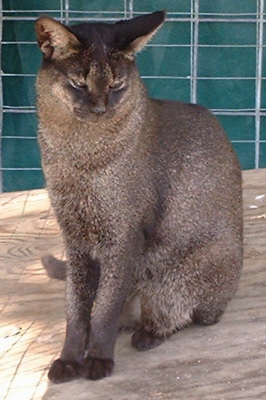
Black Jungle Cats
Jungle cats, Felis chaus, are also known as Swamp cats. They were available as pets in tropical countries and many were kept on ships as ratters.
George Markie believes that Jungle cats may have jumped ship in ports such as Dundee, Glasgow, Greenock and Leith while reserachers in England and Wales believe Jungle Cats may ahve arrived at Plymouth, Southampton, Cardiff and Swansea. George has suggested that some of the cats which are seen could be the offspring of Jungle cats which jumped ship and then cross bred with local domestic cats or even wild cats over the past two hundred years or so.
Phebe Cooper reports that Hayling Island on the south Coast of England has a population of jungle cats.
Melanistic Jungle Cats are known. It should be noted that melanism in the Jungle Cat, as with the jaguar, appears to be due to a dominant gene as a pair of black Jungle cats in Cincinnati zoo had both black and normal coloured offspring (Von Lottar, 1979).
The following photo of a black Jungle cat was taken by Ben Willis, who discusses possible Jungle cat genes in Scottish Kellas cats.
 Earlier this week my wife and I took a short vacation and visited an exotic cat sanctuary located in Mebane, North Carolina. Various species of abandoned cats are housed there including a number of jungle cats, one a melanistic female.
Earlier this week my wife and I took a short vacation and visited an exotic cat sanctuary located in Mebane, North Carolina. Various species of abandoned cats are housed there including a number of jungle cats, one a melanistic female.
I had seen this cat previously in March of this year, but as she was less than coopertive in only giving me a fleeting glimpse, I was particularly interested in comparing her to the Kellas Cat.
I was surprised to find that she will now sit still in the enclosure giving me a good look and a few pictures. I was also surprised to find that her former jet-black coat has now changed to a silver grey.
After observing this cat, and a number of the standard brown Jungle Cats, I am of a less opinion that there is any close relationship between them and Kellas.
There are a number of characterisics which do not match the Kellas, and I believe they are all signifiant. The jaws, teeth, and the overall bone structure appears much more delicate and fragile than even most domestic cats. Unlike the stronger more robust appearance of the bobcat, and domestic to a lesser degree, these cats remind me more of a very immature domestic cat, even though the Jungle Cats are large. Both their feet and tails are smaller in proportion with the domestic, the tails being long and thin as opposed to the thicker tail of the Kellas and Wildcat.
Comparing my own black cat to the few pictures of the Kellas cats in Di Francis's book, I am more inclined to think the Kellas ancestry would be that of the domestic cat. In his case, he shares the long heavy canines, the general head shape, the higher shoulders which cause a recessed area along the back-bone, the thicker tail ending in a point, leathery ears, and a reddish tint to his black coat. None of the Jungle Cats seemed to share these characteristics.
The one similarity the Jungle and Kellas seem to share are especially long legs. I do seem to recall reading that the legs of the Kellas did appear longer, but on examinatin were actually shorter than the wildcat however.
I must say though, this is only a laymans observation. I will post the pictures I took over the next few days and everyone can have a look and form their own opinions.
Regards
Ben Willis
This picture is a melanistic Jungle Cat I visited last week. Last March this cat was a solid jet-black. I'm told this particular cat is around three years old. Its larger than most domestic cats but only slightly. I estimated it to be about the same as my black cat and smaller than the bobcat. The coat color is seasonal and will return to its natural black within the next few months. Just as my black cat will change to a reddish shade, the Jungle Cat becomes more silvery.
This coat color is another reason I'm less inclined to consider the Kellas Cats to be of Jungle Cat origin. The Kellas Cats were of a reddish tint in their black coats. Almost all the black ferals that were born here began as either light brown or grey. Over a period of weeks or months, they gradually turned black. Most of the seasonal color change is due to dead fur which remains
in the new coat
I also have some pictures I made of a melanistic leopard which I will post within the next few days. It also has turned to a rufus shade which is very clear in the photograph.
Regards
Ben Willis
 |
 |
 |
| Return to index | Return to Scottish Big Cats | Return to Wild Cats |